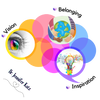What is Social & Emotional Learning?
Block One examines Social and Emotional Learning, and involves building compassionate learning communities in which all students feel safe, valued, and have a sense of belonging. The term "social and emotional learning" was coined by CASEL, a group dedicated to supporting SEL in schools. Toward this goal, the Three-Block Model uses three main strategies:
Furthermore mental health has increasingly become a topic of interest in the field of healthcare and education, particularly since the onset of the COVID pandemic. In Canada, youth with good mental health dropped from 71% in 2015 to 38.5% in 2020 (Garriguet, 2021; Statistics Canada, 2020), and suicidal ideation was higher than before the pandemic (Liu et al., 2022). However, only 20 percent of students who needed mental health intervention received services in Canada (Smetanin et al., 2011). Considering fewer students had received assessments and interventions during the pandemic due to the restrictions, mental health service needs are expected to continue to increase moving forward (Ritchie et al., 2021).
Schools are the only institutions that can reach all Canadian children. If we are to support the 80% of students needing mental health care who are currently not receiving any, the schools will have to play a significant role. Since schools also lack the ability to provide individualized mental health support to every student needing it, classroom based mental health programs that teachers themselves can deliver are called for as a tier one, proactive support. While teachers cannot provide therapeutic intervention, it is possible for teachers to implement programs that build coping skills, strategies for managing stress and anxiety, mindfulness, and similar protective factors (Andreu et al, 2023).
Toward this end, we have put forward to classroom-based mental health programs:
These strategies are detailed in chapter 6 of "Ensouling Our Schools."
- Spirit Buddies
- Democratic Classrooms
- The Respecting Diversity Program - used at the beginning of the school year to develop student self-concept, respect for diverse others, and an inclusive classroom climate. The program involves eight lessons that introduce students to their own and other learning profiles, and how diversity benefits a community.
Furthermore mental health has increasingly become a topic of interest in the field of healthcare and education, particularly since the onset of the COVID pandemic. In Canada, youth with good mental health dropped from 71% in 2015 to 38.5% in 2020 (Garriguet, 2021; Statistics Canada, 2020), and suicidal ideation was higher than before the pandemic (Liu et al., 2022). However, only 20 percent of students who needed mental health intervention received services in Canada (Smetanin et al., 2011). Considering fewer students had received assessments and interventions during the pandemic due to the restrictions, mental health service needs are expected to continue to increase moving forward (Ritchie et al., 2021).
Schools are the only institutions that can reach all Canadian children. If we are to support the 80% of students needing mental health care who are currently not receiving any, the schools will have to play a significant role. Since schools also lack the ability to provide individualized mental health support to every student needing it, classroom based mental health programs that teachers themselves can deliver are called for as a tier one, proactive support. While teachers cannot provide therapeutic intervention, it is possible for teachers to implement programs that build coping skills, strategies for managing stress and anxiety, mindfulness, and similar protective factors (Andreu et al, 2023).
Toward this end, we have put forward to classroom-based mental health programs:
- The Brain Unit
- DBT Skills Modules from a UDL lens
These strategies are detailed in chapter 6 of "Ensouling Our Schools."
Why It Matters
Positive relationships rather than risk factors have the more profound impact on prognosis.
- This means that a student who is highly at risk due to family, health or other factors, is helped to develop resiliency and is more likely not to engage in risky behaviors such as substance abuse, aggression, and suicide when a significant relationship, whether with a family, school, or community member, is present.
- In contrast, a student who does not have such risk factors is more likely to engage in risky behavior if there is no significant relationship in their life.
- The teacher-student relationship can therefore have significant buffering effects, and conversely, can have significantly negative impacts on student mental health, learning, and school completion.
So the question every educator must answer is...
WHAT IS YOUR CHOICE
TO WOUND OR TO HEAL?
WHAT IS YOUR CHOICE
TO WOUND OR TO HEAL?
The reality is, as dramatic as that sounds, it's the truth. From our body language, to our tone of voice, from our words, to our actions, and even from the instructional activities we design that either breed success or failure - we make this choice every day.
The students most likely to receive negative feedback, are also the ones most in need of that one person who believes in them. Will that be you?
The students most likely to receive negative feedback, are also the ones most in need of that one person who believes in them. Will that be you?
